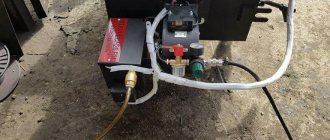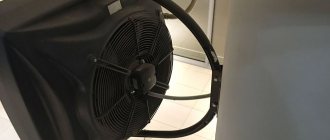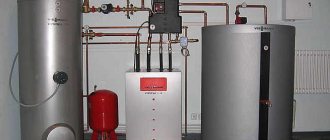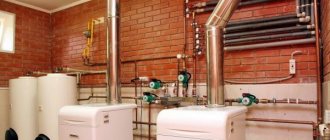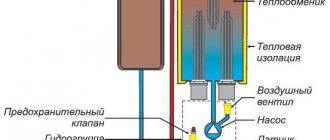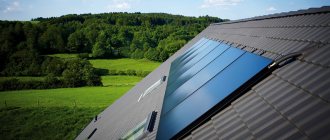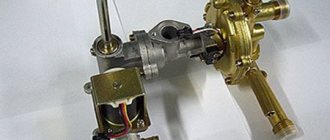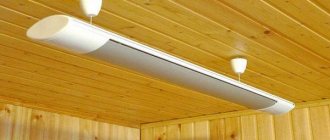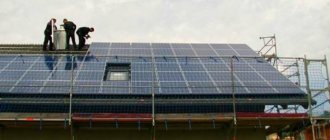How does a solar collector system work?
A modern solar collector system is designed as follows. The sun's rays heat the coolant fluid in the collector. This liquid circulates from the collector to the heat exchanger in a heating device - a water boiler. Circulation is carried out using a pump. The solar system also includes a control unit (controller) that regulates the operation of the pump, includes overheating protection and performs some other tasks.
ViessmannSolar collectors are also successfully used in countries with temperate climates.
ShutterStock/Fotodom.ru
Automation of heating and hot water systems with a solar collector
Heating and hot water systems with a solar collector must be equipped with automation devices.
Automation is necessary for coordinated control of the operation of several energy sources - solar collector, boiler, electric heater, as well as circulation pumps.
Sensors measure the temperature of the coolant at heating sources and the temperature of water in the storage tank. The control unit, according to a given program, analyzes the indicators of the sensors and issues commands to turn on or off certain heating sources, pumps and valves.
A person has the opportunity to set control parameters - for example, set the maximum temperature of hot water.
How does a solar water heater work?
Such a heater is assembled from the following components:
- The collector is a radiator consisting of copper tubes packed in sealed glass containers - vacuum flasks. In this case, water or other coolant is pumped into the heat (copper) tubes of the collector, and the solar radiator itself is mounted at an angle to the horizontal, placed on a special bracket.
- Storage tank - a container with water that absorbs the energy of the coolant circulating through the collector. Moreover, the water in the storage tank is heated by the coolant coming from the collector or by energy from the internal radiator embedded in the tank and connected to the collector by a network of pipelines.
- Pressure equipment - a water pump that circulates the coolant.
- Pipe fittings connecting the collector and storage tank or the collector and the internal radiator of the storage tank.
Solar water heater device
These nodes interact with each other according to the following scheme:
- Water poured into the collector absorbs the heat of the sun's rays, heats up and rises to the upper part of the heat pipe, encouraging the natural circulation of the coolant. In this case, the temperature of the water in the vacuum tube rises to 300 degrees Celsius.
- The pressure in the heat pipes of the collector, caused by the difference in density of hot and cold water, is transmitted through the corresponding branch of the fittings connecting the external radiator and the storage tank. If natural impulse is not enough, then a pump comes into play, generating mechanical pressure.
- Under the influence of natural or mechanical impulse, hot water leaves the solar collector of the water heater and moves into the storage tank, increasing the temperature in this tank. In this case, the coolant from the collector is mixed with the water of the storage tank or circulates through an internal radiator built into the tank.
- The hot water that has moved into the tank creates a vacuum in the lower part of the collector, sucking cold water from the storage tank or internal radiator into the external radiator. If the vacuum is insufficient, the situation will be corrected by a pressure pump pumping cold water into the heat pipe of the vacuum flask.
As a result, solar heat, heating the coolant located outside the house in the collector, also heats the water in the storage tank, which will be consumed by users of such a water heater.
How to make a simple water heater with your own hands
Polycarbonate
One of the options for manufacturing a solar water heater involves using cellular polycarbonate in the design. The only requirement for this structural element is the light transmittance of the material. Strength is also an important characteristic, but is not the main one.
From available materials, it can be various lumber or light profile metal elements, the frame of the device is made. A coil is constructed from copper tubes, preferably in one plane - this is the absorber of the device through which water will circulate.
Fittings are mounted at the ends of the copper tube to connect the supply pipe and the heated water outlet. As a coil, you can use a similar design from an old refrigerator, but in this case, the parameters of the refrigerator coil will determine the geometric dimensions of the entire device.
The coil is placed into the housing, the entire structure is insulated with heat-insulating material and covered on the outside with a polycarbonate sheet.
The water heater is installed in a selected area in accordance with the geographical location and is connected to the cold water supply and the heated water consumption system.
Types of solar collectors
Solar systems are divided into two classes according to the heating principle and the method of storing the coolant. The first ones use a built-in heat accumulator tank. The latter are connected to a remote storage tank installed in close proximity to the collector or inside the building.
When choosing a solar system, first of all, pay attention to the type of solar thermal energy storage tanks, since differences in design and device are reflected in the operating features and technical characteristics.
Manifolds with built-in tank
Monoblock solar collectors are designed for operation in the spring-autumn season. In winter, the equipment is turned off and the coolant is drained. Collectors with a built-in tank are easier to install and maintain. To use, you simply need to connect the solar system to the hot water supply system or water collection point.
Heating of water from solar collectors with a built-in heat accumulator tank occurs as follows:
- the sun's rays are captured by the absorber;
- the resulting energy is transferred to a coil located in a built-in heat accumulator tank;
- heat is transferred from the heated coolant to water used for domestic needs.
Some heat storage tanks have a built-in heating element, which is necessary in cases where the solar collector could not provide the required amount of hot water. Underheating is possible in case of cloudy or cold weather. Under normal conditions, a solar collector can heat a volume of water up to 200 liters. in a day.
Manifolds with a built-in tank generally operate without pressure, using natural circulation of liquid. Thermosiphon solar systems are installed at the highest point of the hot water supply system to ensure the required water pressure when the water supply tap is opened. The tanks can withstand a maximum pressure of no more than 0.2 atm. After heating, the water flows by gravity to the water collection point.
Solar water heaters with a built-in tank have several advantages:
- heating water in sunny weather in just 3-4 hours;
- meeting the need for domestic hot water from 3 people and above, depending on the area of the absorbent surface;
- simple installation;
- low price.
The thermosyphon principle is widely used in hot water supply systems with solar collectors. The operation of a water heater is based on natural convection, when heated liquid moves upward and cooled liquid falls down. An indispensable condition for the DHW thermosyphon circuit is that the water tank must be located above the collector.
Solar systems with a remote tank
Solar collectors connected to a separate heat storage tank belong to the class of water heaters for year-round use. Water heating continues at any time of the year, provided that the sun shines brightly and the air temperature does not fall below –50°C.
To heat water, an external indirect heating boiler is used, remote from the heat source. Antifreeze is used as a coolant. DHW heating by a collector with a remote tank is carried out as follows:
- the absorber accumulates heat and transfers it to the coolant fluid;
- under pressure, heated antifreeze enters the heat exchanger of the storage tank;
- When passing through the tank coil, the coolant heats the water.
To ensure normal operation, a solar collector with a remote tank is connected to the pumping group. Coolant circulation is forced. The heating process and intensity and pressure are regulated automatically.
The main advantage of solar systems with a remote tank is the possibility of year-round use. Disadvantage: the need to connect expensive equipment necessary for the normal operation of the solar system. A water heater operating under pressure has one more disadvantage: when there is a power outage, the pumps stop working, which leads to overheating of the coolant and negatively affects the performance of the solar collector (the problem is solved by installing a UPS).
Flat
- Used in systems with direct and indirect water heating.
In this case, the installation consists of a carrier, with a thermal insulation device, a frame and a device for absorbing solar energy (absorber). Copper tubes are used as an absorber; the frame is covered with glass on the outside. This type of construction is the most common compared to others.
The advantages of this design include:
- Possibility of application for various types of systems;
- Device reliability;
- High efficiency of devices;
- Unpretentiousness to operating conditions;
- Long service life.
The disadvantages are:
- Low efficiency of installations;
- If damaged, a complete replacement is required.
Vacuum
- Devices of this type are used in systems with indirect water heating.
The basis of this design is a vacuum pipe consisting of two tubes of different diameters, placed one inside the other with a vacuum gap between them. Several tubes are placed in a single housing, and their tops are placed in a single block through which water from an external source circulates.
The sun's rays fall on the outer tubes, which act as an absorber. In copper tubes of smaller diameter, a special liquid is heated, which, when heated, begins to evaporate. The steam rises upward, where it transfers its energy to the circulating water, after which it condenses and flows down.
The advantages of this design include:
- Possibility of year-round use;
- High efficiency of devices;
- Versatility of use.
The disadvantages are:
- The service life is short compared to analogues;
- Susceptibility to destruction under the influence of external factors;
- Large overall dimensions and weight of devices;
- Cannot be used in regions with negative outside temperatures.
Liquid
From the name it is clear that the main coolant in them is liquid. A do-it-yourself water solar collector is made according to the following scheme. Through a metal plate that absorbs solar energy, heat is transferred through pipes attached to it into a tank with water or antifreeze liquid or directly to the consumer.
Two pipes approach the plate. Through one of them, cold water is supplied from the tank, and through the second, already heated liquid enters the tank. Pipes must have inlet and outlet openings. This heating circuit is called closed.
When heated water is directly supplied to meet the needs of the user, such a system is called open-loop.
Non-glazed ones are more often used to heat water in a swimming pool, so assembling such thermal solar collectors with your own hands does not require the purchase of expensive materials - rubber and plastic will do. Glazed ones have higher efficiency, so they are able to heat the house and provide the consumer with hot water.
Air
Air devices are more economical than the above-mentioned analogs that use water as a coolant. The air does not freeze, does not leak, and does not boil like water. If a leak occurs in such a system, it does not cause as many problems, but it is quite difficult to determine where it occurred.
Self-production does not cost the consumer much. The sun receiving panel, which is covered with glass, heats the air that is between it and the heat-insulating plate. Roughly speaking, this is a flat-plate collector with space for air inside. Cold air enters inside and, under the influence of solar energy, warm air is supplied to the consumer.
A fan, which is attached to the duct or directly to the plate, improves circulation and improves air exchange in the device. The fan requires the use of electricity to operate, which is not very economical.
Such options are durable and reliable and are easier to maintain than devices that use liquid as a coolant. To maintain the desired air temperature in the cellar or to heat a greenhouse with a solar collector, just this option is suitable.
Cumulative
Storage collectors are also called thermosiphon collectors. This DIY solar collector without a pump is the most profitable. Its capabilities allow you not only to heat water, but also to maintain the temperature at the required level for some time.
This solar heating collector consists of several tanks filled with water, which are located in a thermal insulation box. The tanks are covered with a glass lid, through which the sun's rays shine through and heat the water. This option is the most economical, easy to operate and maintain, but its effectiveness in winter is practically zero.
Types of solar water heaters: choosing a design for self-production
Depending on the temperature developed by solar heaters, there are:
- low-temperature devices - designed to heat liquids up to 50 °C;
- medium-temperature solar collectors - increase the outlet water temperature to 80 °C;
- high-temperature installations - heat the coolant to boiling point.
At home, you can build a solar water heater of the first or second type. To manufacture a high-temperature collector, you will need industrial equipment, new technologies and expensive materials.
By design, all liquid solar collectors are divided into three types:
- flat water heaters;
- vacuum thermosiphon devices;
- solar concentrators.
A flat solar collector is a low, thermally insulated box. A light-absorbing plate and a tubular circuit are installed inside. The absorbent panel (absorber) has increased thermal conductivity. Due to this, it is possible to achieve maximum energy transfer to the coolant circulating through the water heater circuit. The simplicity and efficiency of flat installations is reflected in numerous designs developed by folk craftsmen.
Inside the flat solar collector there is a light-absorbing plate and a tubular circuit
The operating principle of vacuum solar water heaters is based on the thermos effect. The design is based on dozens of double glass flasks. The outer tube is made of impact-resistant, tempered glass that resists hail and wind. The inner tube has a special coating to increase light absorption capacity. Air has been evacuated from the space between the elements of the flask, which avoids heat losses. In the center of the structure there is a copper thermal circuit filled with a low-boiling coolant (freon) - this is the heater of the vacuum solar collector. During the process, the process fluid evaporates and transfers thermal energy to the working fluid of the main circuit. Antifreeze is often used for this purpose. This design ensures system operation at temperatures down to -50 °C. It is difficult to build such an installation at home, so there are only a few homemade vacuum-type structures.
The design of the vacuum solar collector is based on many double glass flasks
The solar concentrator is based on a spherical mirror capable of focusing solar radiation to a point. The liquid is heated in a spiral metal circuit, which is placed at the focal point of the installation. The advantage of solar concentrators is their ability to develop high temperatures, but the need for a solar tracking system reduces their popularity among DIYers.
Building a productive solar concentrator at home is not an easy task
For home use, flat panel solar heaters built using thermal insulation materials, high transmittance glass, and copper absorbers are the best options.
Solar water heaters for home – overview of popular models
The most popular models of solar water heaters include the following models:
Water heater POWER15 1.72M2 - this collector is assembled from 10-15 vacuum flasks, forming an active area measuring up to 2.5 square meters. And taking into account the fact that the sun emits up to 1.3 kW per square meter, the thermal power of such a system is very decent, even taking into account the 76 percent efficiency of this particular model.
Water heater POWER15 1.72M2
At the same time, a sufficiently large volume of liquid can be passed through such a collector, supplied to the heat pipes under a pressure of up to 6 atmospheres. The temperature of the coolant heated in POWER15 1.72M2 reaches 330 degrees Celsius.
The cost of the collector (without fittings, pump and tank) is 145,000 rubles.
Water heater Azuro Shelter 1.2x1x0.9m made in the Czech Republic,
Water heater Azuro Shelter
collecting sunlight from an area of 1.8 square meters. This particular panel is used to heat the water in the pool. The Azuro Shelter model can raise the temperature in a medium-sized bowl (up to 30 cubic meters) by 6 degrees Celsius, even in the case of a 6-hour sunny day.
The cost of an arc-shaped panel that receives light from all sides is 12 thousand rubles.
German manifold Buderus Logasol CKN 2.0-s,
Manifold Buderus Logasol CKN 2.0-s
suitable for use in open-loop hot water systems. The efficiency of this model is 85 percent, weight is only 30 kilograms (due to the aluminum frame and single-layer glazing). Such a collector heats the coolant up to 170 degrees Celsius and can withstand pressure up to 6 atmospheres.
The cost of the Buderus Logasol CKN 2.0-s model is 42-43 thousand rubles.
Chinese panel manifold Intex 28685
Collector Intex 28685
suitable for heating swimming pools up to 30 cubic meters. The water heater is laid directly on the ground and provides a comfortable temperature in the pool even in northern summer conditions with short sunny days. Moreover, the collector itself is ready for use right out of the box, without preliminary commissioning.
The cost of the product is up to 2 thousand rubles.
Domestic panel type vacuum collector NIBE Solar FP215 series
Panel type vacuum collector NIBE Solar FP215 series
servicing double-circuit indirect heating systems (with an internal radiator in the storage tank). Such a panel occupies almost 2 m2, generating about 1.8-2 kW of thermal energy, which is quite enough for uninterrupted water supply to a medium-sized house or heating a room with an area of up to 20 m2.
The cost of the panel (without tank, fittings and internal radiator) is 125 thousand rubles.
Vacuum manifold from the German manufacturer - Meibes - MVK 001
Vacuum manifold Meibes – MVK 001
The area of this solar heater is 2.6 square meters. Efficiency is 95 percent, which guarantees a maximum coolant temperature of 295 degrees Celsius. The collector body is made of high-strength material – borosilicate glass. Therefore, such a collector can be mounted even on top of the roof. The body of the vacuum flasks can withstand snow loads of up to 300 kilograms per square meter and wind loads equivalent to 150 kg/m2. Up to 6 such modules can be installed in one system, generating up to 16 kW of thermal power.
The cost of one module designed for 2.2 liters of coolant is 96-100 thousand rubles.
Main manufacturers
Solar water heaters have found wide practical application in many European countries, China, Turkey, the USA, Israel, and Saudi Arabia. The production of these products in the world is growing steadily and, along with demand, the number of companies in this segment is increasing.
Let's take a look at some of the major solar water heater companies. So, the top manufacturers on the world market:
- The Italian company produces vacuum-type manifolds KAIROS VT. There are modifications with 15 or 20 tubes;
- The German manufacturer offers three models SKR21, SKR12, SKR6;
- Another German company that produces models with 6 or 12 tubes. Moreover, they can be combined into blocks to increase the power of the system;
- Sunrain Solar Energy. This is a Chinese manufacturer that produces solar water heaters;
- And another German company that offers two water heaters under the brands Vitosol 200 and 300. These models differ in the design of the heating unit;
- Italian manufacturer producing the Ecotube model.
Water heater KAIROS VT
Here it is worth saying that the products of these companies belong to the highest class and are provided with a guarantee, but not everyone can afford it for the money. Therefore, most of the demand on the market is covered by little-known manufacturers.
Average prices
Due to the fact that an increasing number of inhabitants of our planet are trying to use alternative energy sources in everyday life to obtain heat, electricity and hot water supply, therefore the offered range of products is quite wide.
Solar water heaters are produced by enterprises in our country and abroad.
The cost of installation is affected by the country and manufacturer, the design (flat or vacuum) of the water heater, the delivery package and the region of purchase.
The cheapest option will cost the buyer 1500.00 rubles, for this money you can purchase a “Solar water heater for a swimming pool” (China) with the following technical characteristics: water heater blade size - 1200 x 1200 mm, intended for use with filter pumps with a capacity of no more than 9500 l/hour, weight - 3.7 kg.
The solar water heater “DACHA-LUX” (Russia) with a volume of 125.0 liters will cost the buyer 28,850.00 rubles. The delivery set of this device includes: a storage tank, a set of vacuum tubes (15 pieces), and a controller. The absorbing area is 2.35 m2.
The German installation for hot water supply “AuroSTEP plus” can be purchased for a price from 190,000.00 to 450,000.00 rubles, depending on the configuration. For this money, the buyer purchases: a hot water supply system that eliminates the possibility of boiling (Drain-back design), a water heater with a capacity of 150 - 350 liters. and 1 – 3 solar collectors.
The unit is equipped with a control regulator and an additional electric heater.
As can be seen from the above figures, the cost range is very large, so each potential purchaser can choose a device in accordance with the requirements for it.
Prices and what do they depend on?
As for specific figures, water heaters produced in Russia will cost approximately 700-800 US dollars. We are talking about a vacuum type model. Approximately the same prices for similar Chinese products. Water heaters from German manufacturers cost approximately 800-900 euros. It is more expensive, but they come with the necessary fasteners, and copper and stainless steel are used to make the collectors. So the money will not be wasted.
Water heater Viessmann Vitosol 200
The price of a solar water heater is influenced by the following factors:
- Brand;
- Housing and heat sink material;
- build quality;
- method of laying insulating material and the cost of the material itself;
- glass thickness.
Naturally, the price reflects the design differences discussed above.
Using solar energy with the help of modern technologies, you will be able to provide hot water to your private home or garden house. Moreover, you need to make an initial investment, and then the installation will work for free. If you want to save money, then make a solar water heater yourself. But factory systems are, of course, more reliable and functional.
Which one to choose for the pool?
In pool water heating systems, any type and design of solar water heaters can be used.
To mix the water in the pool and normal water circulation, a circulation pump should be installed in the system, this will increase the efficiency of the installation, and for the consumer it will create more comfortable conditions for using the pool.
You can include a storage tank in the system, or you can mount the circuit without it, in which case the pool itself will serve as a storage tank.
The criteria for choosing a water heater for a swimming pool are:
- Location of the water heater, its spatial orientation;
- Type of water heater (cost of device);
- Pool location (outdoor, indoor);
- Pool volume (geometric dimensions and depth);
- Activity of pool use (frequency and number of people);
- Period of use (year-round, seasonal, periodically);
- Required temperature regime of water in the pool;
- Pool water supply system (type of circuit, throughput and other technical characteristics).
The water heating system for swimming pools works according to the following scheme: a temperature sensor installed in the pool determines the specified water parameters. When the temperature is lower than that set by the consumer, the circulation pump is turned on based on the sensor signal and water from the pool enters the heat exchanger of the heater, where its temperature rises. When the water in the pool reaches the desired temperature, the controller turns off the circulation pump and heating stops. If the solar water heater cools down, the valves close and no water flows into the heat exchanger.
It is very important to position the device correctly, as this will affect its performance. During operation of the water heater, losses of thermal energy are possible, which occur when:
- Evaporation of water in all parts of the system;
- Use of the pool by consumers (bathing users);
- Carrying out preventive maintenance and repair of system devices;
- Due to the thermal conductivity of the pool enclosing structures and the difference in temperature of the water, structures and surrounding air.
Based on the criteria for choosing a device, operating conditions and taking into account the likely losses during operation of the water heater, you can choose a model from various price groups, manufacturers and based on user reviews, of which there are a sufficient number on the Internet and technical publications.
Reviews of solar water heaters "Dacha-Economy"
Solar collector Dacha-Economy XF-II-24-200 review>>>
The water heater was installed in the Moscow region, Noginsky district, village. Calm.
Solar collector Dacha-Economy XF-II-24-200 review>>>
Solar water heaters of the ANDI Group brand, model XF-II-24-200, provide hot water supply to the Platan Hotel in the village of Loo, a suburb of Sochi. The hotel has 45 rooms for 60-90 people.
Solar collector Dacha-Economy XF-II-18-150 review>>>
Solar collector for a summer residence in the Samara region. Used for taking a shower, washing dishes, heating a summer pool, watering plants and other household and household needs.
Solar collector Dacha-Economy XF-II-15-125 in Italy review>>>
A solar collector of the ANDI Group brand was installed in Puglia, the “heel” of Italy
Solar collector Dacha-Economy XF-II-15-125 in the Komi Republic review>>>
The pressure-free system XF-Ⅱ-15-125 “Dacha-Economy” was installed by the buyer in the village of Tydor, Ust-Vymsky district, Komi Republic.
Solar collector Dacha-Economy XF-II-15-125 review>>>
Solar collector for a bathhouse, greenhouse and summer pool
Purpose of a solar collector, its advantages and disadvantages
A solar water heater (liquid solar collector) is a device that uses solar energy to heat the coolant. It is used for heating premises, organizing hot water supply, heating water in swimming pools, etc.
The solar collector will provide the house with hot water and heat
The prerequisites for using an environmentally friendly water heater is the fact that solar radiation falls on the Earth all year round, although it differs in intensity in winter and summer. Thus, for middle latitudes, the daily amount of energy in the cold season reaches 1–3 kW*h per 1 sq.m, while in the period from March to October this value varies from 4 to 8 kW*h/m2. If we talk about the southern regions, then the numbers can safely be increased by 20–40%.
As you can see, the efficiency of the installation depends on the region, but even in the north of our country, the solar collector will provide the need for hot water - the main thing is that there are fewer clouds in the sky. If we talk about the middle zone and southern regions, then a solar-powered installation can replace a boiler and cover the coolant needs of the heating system in the winter. Of course, we are talking about productive water heaters of several tens of square meters.
Table: distribution of solar energy by region
| Average daily amount of solar radiation, kW*h/m2 | |||||||||
| Murmansk | Arkhangelsk | Saint Petersburg | Moscow | Novosibirsk | Ulan-Ude | Khabarovsk | Rostov-on-Don | Sochi | Nakhodka |
| 2,19 | 2,29 | 2,60 | 2,72 | 2,91 | 3,47 | 3,69 | 3,45 | 4,00 | 3,99 |
| Average daily amount of solar radiation in December, kWh/m2 | |||||||||
| 0 | 0,05 | 0,17 | 0,33 | 0,62 | 0,97 | 1,29 | 1,00 | 1,25 | 2,04 |
| Average daily amount of solar radiation in June, kWh/m2 | |||||||||
| 5,14 | 5,51 | 5,78 | 5,56 | 5,48 | 5,72 | 5,94 | 5,76 | 6,75 | 5,12 |
Solar collectors built at home cannot be compared with factory-made devices, but a homemade solar installation will reduce the cost of heating water for domestic purposes and save electricity when connected to a washing machine and dishwasher.
Advantages of solar water heaters:
- relatively simple design;
- high reliability;
- efficient operation regardless of the time of year;
- long service life;
- possibility of saving gas and electricity;
- no permission required to install equipment;
- small weight;
- ease of installation;
- complete autonomy.
As for the negative aspects, not a single installation for producing alternative energy can do without them. In our case, the disadvantages include:
- high cost of factory equipment;
- dependence of the solar collector efficiency on the season and latitude;
- exposure to hail;
- additional costs for installing a heat storage tank;
- dependence of the energy efficiency of the device on cloudiness.
When considering the pros and cons of solar water heaters, we should not forget about the environmental side of the issue - such installations are safe for humans and do not harm our planet.
A factory solar collector resembles a construction set with which you can quickly assemble an installation of the required performance
Methodology for calculating a solar collector
Calculation of the performance of a solar solar collector is based on the fact that 1 sq.m of installation on a clear day accounts for from 800 to 1 thousand W of thermal energy. The loss of this heat on the back side and walls of the structure is calculated based on the thermal insulation coefficient of the insulation used. If polystyrene foam is used, then its heat loss coefficient is 0.05 W/m × °C. With a material thickness of 10 cm and a temperature difference between inside and outside the structure of 50 °C, the thermal energy loss is 0.05/0.1 × 50 = 25 W. Taking into account the side walls and pipes, this value is doubled. Thus, the total amount of outgoing energy will be 50 W per 1 sq.m of solar heater surface.
To heat 1 liter of water by one degree, 1.16 W of thermal energy will be required, therefore, for our model of a solar collector with an area of 1 sq.m and a temperature difference of 50 °C, it will be possible to obtain a conditional performance coefficient of 800/1.16 = 689.65/kg × ° C. This value shows that an installation with an area of 1 sq.m will heat 20 liters of water at 35 °C within an hour.
The required performance of a solar water heater is calculated using the formula W = Q × V × δT, where Q is the heat capacity of water (1.16 W/kg × °C); V—volume, l; δT is the temperature difference at the inlet and outlet of the installation.
Statistics say that one adult requires 50 liters of hot water per day. On average, for hot water supply it is enough to raise the water temperature by 40 °C, which, when calculated using this formula, requires energy consumption W = 1.16 × 50 × 40 = 2.3 kW. To find out the area of the solar collector, this value must be divided by the amount of solar energy per 1 square meter of surface at a given latitude.
Calculation of the required solar installation parameters
DIY Solar Installation Options
The peculiarity of self-built solar water heaters is that almost all devices have the same design of a thermally insulated box. Often the frame is assembled from lumber and covered with mineral wool and heat-reflecting film. As for the absorber, metal and plastic pipes are used for its production, as well as ready-made components from unnecessary household equipment.
From an old refrigerator condenser
The external heat exchanger of a used refrigerator or freezer is a ready-made solar collector absorber. All that remains to be done is to equip it with a heat-absorbing sheet and install it in the case. Of course, the performance of such a system will be small, but in the warm season, a water heater made from refrigeration equipment parts will cover the hot water needs of a small country house or cottage.
The heat exchanger of an old refrigerator is an almost ready-made absorber for a small solar heater
From a garden hose
A garden hose folded like a snail or a PVC water pipe has a large surface area, which makes it possible to use such a circuit as a water heater for the needs of a summer shower, kitchen or swimming pool heating. Of course, for these purposes it is better to take black materials and be sure to use a storage container, otherwise the absorber will overheat during the peak summer heat.
A flat manifold made from a garden hose is the simplest way to heat water in a pool.
Made from polypropylene or polyethylene pipes
Pipes made of metal-plastic, polyethylene and polypropylene, as well as fittings and devices for their installation, allow you to build solar system circuits of any size and configuration. Such installations have good performance and are used for heating rooms and obtaining hot water for household needs (kitchen, bathroom, etc.).
The advantage of a solar collector made of plastic pipes is its low cost and ease of installation.
From a flat radiator of a heating system
Making a solar collector from a steel radiator does not even require the installation of an absorbent plate. It is enough to cover the device with black heat-resistant paint and mount it in a sealed casing. The productivity of one installation is more than enough for a hot water supply system. If you make several water heaters, you can save on heating your home in cold, sunny weather. By the way, a solar installation assembled from radiators will heat utility rooms, a garage or a greenhouse.
A steel heating radiator will serve as the basis for building an environmentally friendly water heater
From copper tubes
Absorbers built from copper plates and tubes have the highest heat transfer, therefore they are successfully used for heating the coolant of heating systems and in hot water supply. The disadvantages of copper collectors include high labor costs and the cost of materials.
The use of copper pipes and plates for the manufacture of the absorber guarantees high performance of the solar installation
Design and principle of operation of a flat solar collector
A homemade solar water heater consists of a flat wooden frame (box) with a blank back wall. The main element of the device, the absorber, is located at the bottom. Most often it is made of a metal sheet attached to a tubular manifold. The efficiency of energy transfer depends on the contact of the absorber plate with the heat exchanger pipes, so these parts are welded or soldered with a continuous seam.
The liquid circuit itself is an array of vertically installed tubes. In the upper and lower parts they are connected to horizontal pipes of increased diameter, which are intended for supplying and extracting coolant. The inlet and outlet openings for the liquid are located diagonally - this ensures complete heat removal from the heat exchanger elements. Antifreeze for heating systems or other antifreeze solutions are used as a coolant.
The absorber is covered with light-absorbing paint, glass is placed on top, and the box is protected with a layer of thermal insulation. To simplify the task, the glazing area is divided into parts, and to increase productivity, double-glazed windows are used. The closed design creates the effect of a thermos in the solar collector and at the same time prevents heat loss due to wind, rain and other external factors.
The sun is a source of energy available to every person. This article will help you set up a solar collector:
A solar water heater works like this:
- The non-freezing liquid heated in the solar collector rises through the tubes and through the coolant extraction branch enters the heat storage tank.
- Moving through a heat exchanger installed inside the storage tank, the antifreeze transfers heat to the water.
- The cooled working fluid enters the lower part of the solar water heater circuit.
- The water heated in the tank rises and is taken for hot water supply. Liquid replenishment in the heat-storing tank occurs due to the water supply connected to the lower part. If the solar collector works as a heater for the heating system, then a circulation pump is used to circulate water in a closed secondary circuit.
The constant movement of the coolant and the presence of a thermal accumulator allows you to accumulate energy while the sun is shining, and gradually consume it even when the sun disappears beyond the horizon.
The connection diagram of the solar collector to the storage tank is not so complicated
Installation and Orientation
The collector is installed in an open area , illuminated by sunlight throughout the day. The best option is the roof of the house , but any building, tree or elevation located nearby can become a barrier to the rays, so you need to immediately check the lighting density.
Also, the solar system for heating water must be installed so that the rays fall perpendicularly on its surface . To do this, you need to mark the position of the Sun in the middle of daylight and install the panels perpendicular to the rays so that the light falls on them vertically. In this regard , tubular structures are more effective, since they do not have a plane as such, and the surface of the tube receives flow equally well from any side.
Payback period
Solar heating systems, the price of which depends on the size of the house and external conditions in the region, can pay for themselves in a fairly short period of time, or not at all. It is extremely difficult to calculate in advance at what time it will begin to make a profit, since there are too many subtle effects and influencing factors. Weather or climatic circumstances, the level of technical performance of system elements, the type of heating circuits and much more are involved.
A solar installation for heating water is a kind of investment project with a deferred payback period. It is believed that the average lifespan of equipment is 30 years. All this time, the complex will provide a certain amount of thermal energy, for which you do not have to pay anything.
Investments in creating the system are only initial , then occasionally only routine repair work will be needed, which does not require serious expenses. At the end of their service life, all components and elements of the solar system can be used for other purposes or sold as secondary raw materials. Therefore, the economic effect from the work will be obtained in any case , although it is not the main goal of the entire plan.
Advantages and disadvantages
The advantages of using solar power plants include:
- the opportunity to use inexhaustible and completely free solar energy;
- independence from tariffs of resource organizations and suppliers;
- the ability to adjust and change the size of the system at will;
- long service life with minimal repair costs.
The disadvantages of solar systems are:
- the system operates only during the daytime, consuming the accumulated heat at night;
- dependence on weather and climatic conditions;
- low efficiency and overall efficiency of solar installations;
- not all homeowners have the opportunity to create a system;
- in regions with frosty winters the systems cannot work.
When choosing a heating system, you need to know and take into account the advantages and disadvantages of this technique.
Applications and installation requirements
So where are solar water heaters used?
- Hot water supply for a private home;
- Heating;
- Heating of water for country pools;
- Hot water for the needs of agriculture and industry.
Solar water heater for home heating
It is important to consider installation recommendations, since the efficiency of the water heater will entirely depend on this. Here are some recommendations from experts:
- The installation location can be the roof of the house, facade, balcony;
- The water heater panel must face south;
- When installing the panel, you should make an angle equal to the latitude of your region;
- Since the water heater constantly receives solar energy, with low water consumption, stagnation can form, where the coolant can easily heat up to 300 degrees. Therefore, it is prohibited to use pipes made of plastic and galvanized iron. It is best to make a coil made of copper or stainless steel;
- It is imperative to insulate the heating elements of the water heater so as not to accidentally get burned;
- When choosing fasteners and insulation, you should also take into account the possibility of stagnation of the coolant and its strong heating. That is, it is better to choose materials with a margin of safety. Many reputable manufacturers write the stagnation temperature in the specifications or on the device body. Focus on this value;
- Solar water heater panels should be located in an open area with maximum sun exposure. There should be no tall objects around that cast a shadow;
- To increase the efficiency of the water heater, it is necessary to mount it on a special rack, if such an installation scheme is offered by the manufacturer;
- When installing, each type of heater may have its own characteristics. Here you need to follow the manufacturer's recommendations.
Additional costs associated with operation
Using this does not imply any care or maintenance other than periodic cleaning of dirt and snow in winter (unless it thaws itself). However, there will be some associated costs:
- Repairs, everything that can be changed under warranty can be replaced by the manufacturer without any problems, it is important to buy an official dealer and have warranty documents.
- Electricity, very little of it is spent on the pump and controller. For the first one, you can install only 1 solar panel of 300 W and it will be quite enough (even without a battery system).
- Washing the coils will need to be done once every 5-7 years. It all depends on the quality of the water (if it is used as a coolant).
How to install a solar collector
You can install this system yourself. To do this, you need to understand the main principle of installation - maximum sunlight.
- We choose a place
. It should be on the sunny side. To do this, it is enough to observe for several days which place on the site the sun illuminates for as long as possible (you need to avoid getting into the shadows of trees or buildings). Select a starting point and an ending point, and direct the solar collector to the center of these points. This way we will get maximum coverage of thermal radiation. - Tilt angle
. This is an important stage of installation, on which its effectiveness depends. As a rule, such data is provided by the system manufacturer, but on average it is 45 degrees. It cannot be installed at a larger or smaller angle, as this will reduce the absorbing area. - We connect the rest of the equipment
. This is a pump group with a controller, a storage tank and connecting pipes. This is all connected according to the instructions. There is nothing complicated here, since the principle of the device is quite simple.
Features of installation and operation of liquid heating manifolds
To place the solar collector, choose a spacious place that is not shaded throughout the day. The mounting bracket or subframe is made of wooden slats or metal so that the tilt of the water heater is adjusted within the range of 45 to 60 degrees from the vertical axis.
To install the solar water heater, a support frame is assembled
Connection to an indirect heating boiler or heat accumulator is made using threaded fittings and copper, metal-plastic or multilayer polypropylene pipes. They are covered with a layer of thermal insulation.
Connection diagram for a solar heater in a system with forced movement of coolant
To reduce heat losses, the storage tank is placed as close as possible to the installation. Depending on the conditions, natural or forced circulation of the coolant is organized. In the latter case, a controller with a temperature sensor embedded in the outlet pipe is used. Pumping of working fluid through the circuit will turn on when its temperature reaches the programmed value.
A seasonally operating system is charged with water, while year-round use of a solar water heater requires the use of an antifreeze fluid. The ideal option is a special antifreeze for solar systems, but to save money, liquids intended for car radiators or household heating systems are also used.

